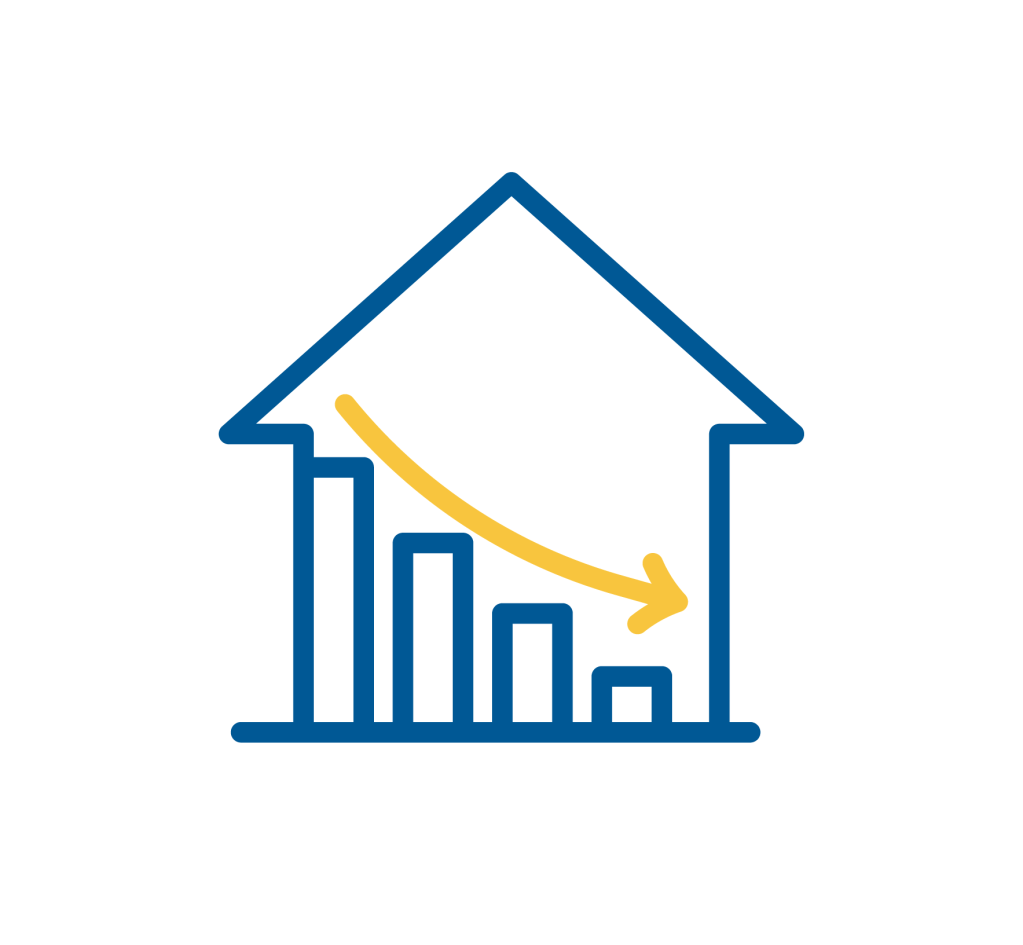The U.S. economy seems in many ways an anomaly.
Interest rates are, by many measures, in “restrictive” territory, and yet the unemployment rate remains quite low. The U.S. is in the midst of a historic trade shock with 100-year high tariffs, but inflation impacts appear limited so far. The housing market, historically a solid leading indicator, is experiencing very limited activity on par with the aftermath of the global financial crisis, yet home prices and rents continue to rise.
The answer to the disconnects, in our view, lies in a series of medium to long-term disruptions that are distorting an economy’s typical responses, and muting the standard “economic cycle.”
At the heart of these disruptions are increasingly powerful structural forces that are masking a very real cyclical slowdown underneath. These disruptions make clarity on the U.S. outlook more difficult, but not impossible. They necessitate a shift in the way we think about the business cycle, cyclical vs. structural trends, and even the way we absorb monthly economic data.
So, while our current U.S. economic outlook is best characterized as Stagflation Lite (growth running too low for comfort coupled with inflation rising somewhat too high for relief), we’re increasingly of the view that the most important economic stories lie beneath the surface of a standard growth forecast like this.


Tariff head fakes: A cycle disrupted from inflation to growth
U.S. tariff policy is creating a significant cyclical disruption, but also likely a structural one that is complicating our ability to read the economy.
Cyclically, imports and inventories surged in Q1 and Q2 on tariff front-running, creating large swings in headline gross domestic product, and an “air pocket” between the implementation of tariffs, and its impact on both inflation and jobs. As we covered here, we expect tariffs to push prices higher into 2026, and also weigh on job growth—a Stagflation Lite type impact. Yet the difficulty in reading the size of the inventory overhang in sectors, coupled with atypical accounting by importers means economists need to reduce convictions in timelines around impact, and visibility into 2025 and 2026 forecasts. Our experience with the 2020 pandemic also tells us that inventory disruptions can take years to normalize. If that seems extreme, consider that goods inflation in the U.S. has only now normalized, five years after the inventory shock of the 2020.
At the same time, it’s reasonable to assume that structural adjustments in response to a re-ordering of trade are also happening. Shifting supply chain strategies take considerable time, but we may be in the early innings of a tanker-sized economic transition. Effectively, that means the manufacturing economy alongside business investment will continue to operate with business-cycle dynamics, but, at the same time, it will be spending and absorbing costs associated with a long-term goal. Disaggregating between the two becomes critical, otherwise there’s the risk of misinterpreting all activity as cyclical.
Why it matters:
-
Headline GDP and inflation aren’t likely to give us a clean read for several quarters, and possibly longer. An increased focus on final domestic purchases is critical for a better pulse on the domestic U.S. economy.
-
As inventory re-calibration creates volatility in the manufacturing cycle, we can expect further disconnects from manufacturing and services activity, reducing the value of manufacturing as a leading economic indicator—similar to in the aftermath of the pandemic.
-
There will be ongoing sectoral divides between trade-exposed sectors and the rest in the short- and medium-term. Headline growth data is unlikely to be representative of the economy in its entirety. Bottom-up economic analysis will grow in importance.
Read more about our view on how tariffs are likely to impact the U.S. economy here.

Two Americas: Emergence of the K-shape economy
It’s always been true that high-income households contribute a disproportionate share of consumption compared to low- and middle-income groups. But historically, all consumers mostly followed the same economic cycle, and improving economic data generally referred to better conditions for most.
Over the last several years, however, low- and middle-income Americans’ economic circumstances have sharply diverged from their high-income counterparts. The root of the divergence is high income households have benefited from higher interest rate environments (higher returns on savings), and wealth benefits from a surging stock and housing markets. Lower- and middle-income households largely missed out on wealth gains, and have also felt larger inflationary burdens as rent and food price increases are disproportionately painful for this group.
The result is a growing divide in sentiment aligned with circumstance between Americans. And with it, a need to read economic data—and the cycle—differently. Notably, soft data (survey data) has seen much less value as a forecasting tool. It effectively oversamples low- and middle-income households over high-income households, who are disproportionate spenders. At the same time, aggregate economic data is also likely overstating the economic circumstances of many Americans. For companies that serve low- and middle-income Americans, this is a critical distinction.
Why it matters:
-
Expect the divergence between soft and hard data to persist as sentiment reflects all income levels while actual spending is skewed towards higher-income consumers. This reduces the value of surveys, particularly confidence data, as a leading indicator of the real economy.
-
Headline data will show the average “consumer,” but we should avoid generalizing, as it increasingly misses the economic reality for much of the population.
-
When forecasting aggregate consumer behavior, there is a growing need to focus on high-income households driving spending, while leaving equal-weighted patterns for policy or company-level analyses.

America needs workers: A shifting new labor market
Assessing the labor market, and its signals about the underlying economy will increasingly be a precision exercise in isolating the demand for workers against the supply.
Massive and accelerating retirements, coupled with a low immigration policy are likely to continue to weigh on labor force participation rates, and limit the availability of workers. This tension in the demand versus supply of labor is already visible 2025 jobs data. Job growth has slowed from an average 168,000 per month in 2024 to 74,000 per month in 2025, and yet the unemployment rate has remained extraordinarily tight by historical standards. The core of the story is a simple, but powerful one: The U.S. economy needs to create fewer jobs for fewer workers.
There are several important implications. Three, in particular, stand out:
-
For the past five decades, accelerating job growth has signaled the U.S. economy is improving, and weaker or negative job growth has been a surefire signal of a coming slowdown or recession. In our view, this will be decreasingly true.
-
The aging of the population (and workforce) also mean shifting needs for certain skills, particularly, with respect to health care. It’s not surprising that over half of the job gains in the first eight months of 2025 were health care positions. This isn’t a reflection of cyclical demand, and a booming economy, but of a structural dynamic—meaning the total number of jobs and their composition are being impacted by this demographic tidal wave. These jobs, coupled with growing government positions, are also less likely to be impacted by the standard business cycle, reducing the cyclicality of the job market further.
-
An unemployment rate that stays structurally low (with some cyclical variation), also reduces the labor market as a transmission mechanism for weak business activity. For example, large spikes in unemployment are less likely, and the share of the population that is impacted by labor market weakness is smaller.
Why it matters:
-
The unemployment rate is likely to become a less valuable cyclical indicator, and headline job growth needs to be partitioned out into cyclical vs. acyclical job sectors to get a true read on the domestic private economy.
-
Labor market tightness is likely to put a floor under wage growth decelerations, and this adds further challenges to bringing down services inflation.
-
As retirees take up a greater share of the population, incomes are becoming less sensitive to labor market developments. About 20% of all income in the U.S. is now transfers from governments, untied to the economic cycle. Similarly, consumption activity is likely to become cyclically tied to the economic cycle.
Read more about our view that America needs workers, not jobs here.

Forever big government: The cost of a constant floor under the economy
By almost every measure, U.S. federal government spending is running at or near all-time highs.
Naturally, this has ushered in concerns about the sustainability of government spending and Washington’s ability to pay for growing debts. These are important concerns, but they aren’t the only considerations. As the size of government grows and spending at these historic levels persist, big government also create structural disruptions to our readings of the economic cycle.
-
Big government is likely muting the economic cycle on both the downside and upside. Instead of the traditional “counter-cyclical” government spending, the post-COVID period hasn’t just been characterized by the magnitude of spend, but also its pro-cyclical nature. Like guardrails on an economy, the sheer magnitude of government spending limits how weak the economy can become in aggregate. At the same time, since public sector spending tends to be less efficient with lower productivity, a growing government may be putting a ceiling on growth over the medium-run as well.
-
Fiscal policy is increasingly influencing the direction and composition of the economy and that’s, particularly, true relative to monetary policy. This is most clear in the shape of the yield curve—the front-end falling on the back of expected rate cuts, but the long-end of the curve at the mercy of fiscal sustainability. Problematically, this will add further pressure to costs as interest expenses continue to climb.
-
The attention might be predominantly on government spending, but the requirements of government are also rising as the population ages, putting additional pressures on social security, Medicare expenses, and the labor market. Health care and social assistance and public sector jobs now make up one in three jobs in the U.S.
Why it matters:
-
Big government is muting the Economic cycle, reducing the odds of technical recessions in headline figures, but also potentially limiting the upside of the economy as well.
-
Governments are far less cyclical, or even counter-cyclical in nature. As government jobs become a larger share of the work force over time, economic weakness is less likely to bleed into broader labor and income statistics.

A housing market held hostage: The lost growth engine
The U.S. housing market is in a deep freeze, held hostage by the double whammy of 30-year mortgage rates floating around two-decade highs, and the “lock-in” effect of mortgage-holders carrying historically low pandemic-era mortgage rates.
The bulk of housing data looks clearly recessionary. For the past three years, the volume of existing home sales have been trending around levels not seen since the global financial crisis, consumer confidence in buying a home is at a record low, along with housing affordability for first-time homebuyers. Historically, this would have been a three-alarm bell for the U.S. economy as housing has historically led the economic cycle. But, the sector has dragged on total growth for nine of the past 14 quarters without pulling the broader economy down with it. Meanwhile, in contradiction, home prices are still up.
Part of housing’s disconnect lies in the sector’s decreased interest rate sensitivity—another consequence of an aging population. High interest rates are another barrier in a structural shortage of housing supply. Together, these forces imply a housing economy that is now desynchronized from the business cycle as a whole. It disrupts our standard approach to the sector, and its implications for the broad economy.
Why it matters:
-
Housing is, at least for now, a lost growth engine for the U.S. economy, limiting upsides to growth and providing reduced value as a cyclical indicator.
-
Monetary policy has become a less helpful tool at stimulating the housing market as most mortgage holders are still benefiting from pandemic-level interest rates. These mortgage holders were unaffected by rising rates, and will similarly be less sensitive to falling rates absent a return to the zero lower bound.
-
The economy may become more sensitive to rental markets and rents, in general as home ownership levels decline.
-
As retirees move into retirement communities and other assisted living facilities, the demographic shift may put downward pressure on prices. But, this will be a more regional theme, not cyclical.

About the Authors
Frances Donald is the Chief Economist at RBC and oversees a team of leading professionals, who deliver economic analyses and insights to inform RBC clients around the globe. Frances is a key expert on economic issues and is highly sought after by clients, government leaders, policy makers, and media in the U.S. and Canada.
Mike Reid is a Senior U.S. Economist at RBC. He is responsible for generating RBC’s U.S. economic outlook, providing commentary on macro indicators, and producing written analysis around the economic backdrop.
Carrie Freestone is an economist and a member of the macroeconomic analysis group. She is responsible for examining key economic trends including consumer spending, labour markets, GDP, and inflation.
This article is intended as general information only and is not to be relied upon as constituting legal, financial or other professional advice. The reader is solely liable for any use of the information contained in this document and Royal Bank of Canada (“RBC”) nor any of its affiliates nor any of their respective directors, officers, employees or agents shall be held responsible for any direct or indirect damages arising from the use of this document by the reader. A professional advisor should be consulted regarding your specific situation. Information presented is believed to be factual and up-to-date but we do not guarantee its accuracy and it should not be regarded as a complete analysis of the subjects discussed. All expressions of opinion reflect the judgment of the authors as of the date of publication and are subject to change. No endorsement of any third parties or their advice, opinions, information, products or services is expressly given or implied by Royal Bank of Canada or any of its affiliates.
This document may contain forward-looking statements within the meaning of certain securities laws, which are subject to RBC’s caution regarding forward-looking statements. ESG (including climate) metrics, data and other information contained on this website are or may be based on assumptions, estimates and judgements. For cautionary statements relating to the information on this website, refer to the “Caution regarding forward-looking statements” and the “Important notice regarding this document” sections in our latest climate report or sustainability report, available at: https://www.rbc.com/community-social-impact/reporting-performance/index.html. Except as required by law, none of RBC nor any of its affiliates undertake to update any information in this document.


